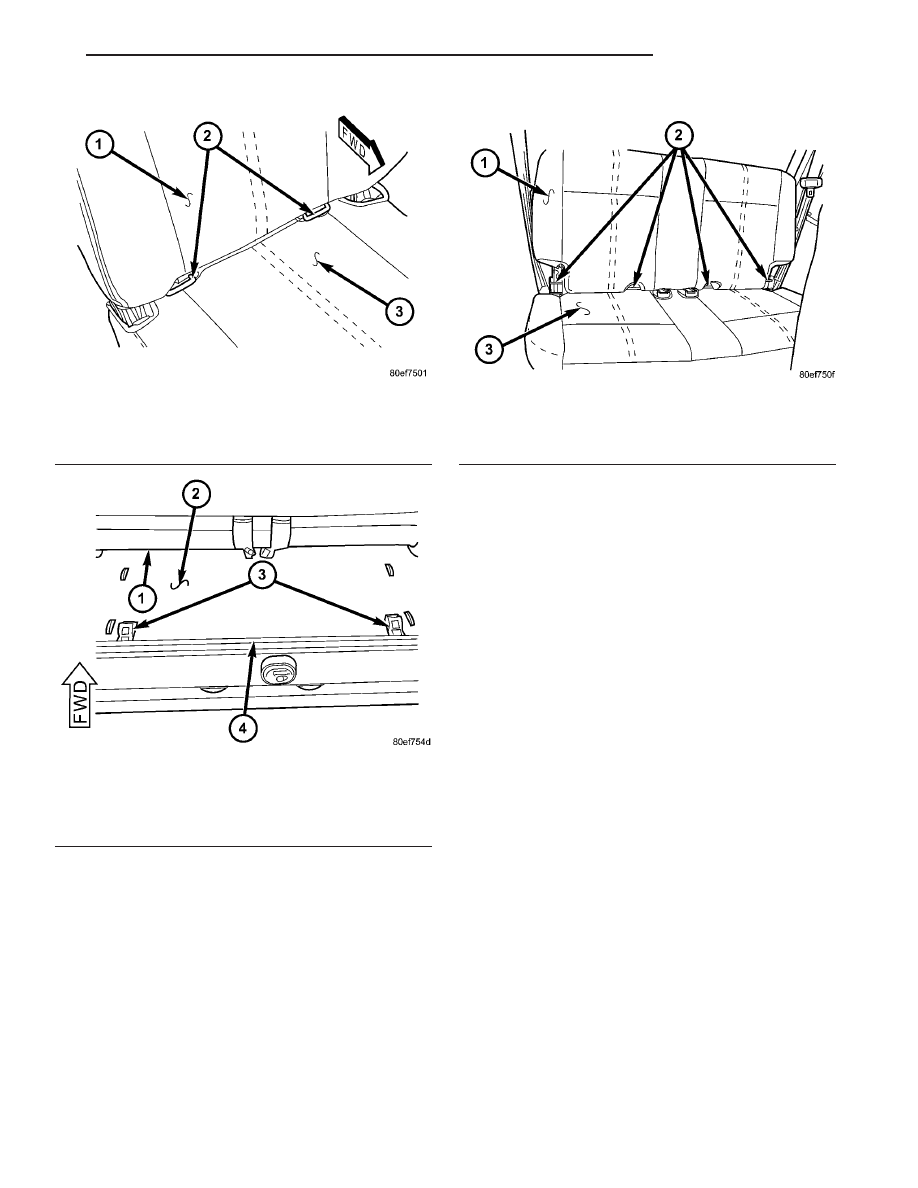Jeep Wrangler TJ. Manual - part 322

opening, and are accessed from behind the rear seat.
The upper tether anchors for the rear seat are avail-
able for individual service replacement. The four
fixed lower anchors are integral to the rear seat back
frame and are accessed from the front of the rear
seat, where the seat back meets the seat cushion.
The two inboard lower anchors are constructed from
round steel bar stock that is formed into a U-shape,
then securely welded at each end to the rear seat
back frame. The two outboard lower anchors are
machined steel pins that are secured between the
two seat back hinge plates above the pivot pin on
each outboard side of the rear seat back frame. These
lower anchors cannot be adjusted or repaired and, if
faulty or damaged, they must be replaced as a unit
with the rear seat back frame.
WARNING: DURING AND FOLLOWING ANY SEAT
BELT OR CHILD RESTRAINT ANCHOR SERVICE,
CAREFULLY INSPECT ALL SEAT BELTS, BUCKLES,
MOUNTING HARDWARE, RETRACTORS, TETHER
STRAPS, AND ANCHORS FOR PROPER INSTALLA-
TION, OPERATION, OR DAMAGE. REPLACE ANY
BELT
THAT
IS
CUT,
FRAYED,
OR
TORN.
STRAIGHTEN
ANY
BELT
THAT
IS
TWISTED.
TIGHTEN ANY LOOSE FASTENERS. REPLACE ANY
BELT THAT HAS A DAMAGED OR INOPERATIVE
BUCKLE OR RETRACTOR. REPLACE ANY BELT
THAT HAS A BENT OR DAMAGED LATCH PLATE
OR
ANCHOR
PLATE.
REPLACE
ANY
CHILD
RESTRAINT ANCHOR OR THE UNIT TO WHICH THE
ANCHOR IS INTEGRAL THAT HAS BEEN BENT OR
DAMAGED. NEVER ATTEMPT TO REPAIR A SEAT
BELT
OR
CHILD
RESTRAINT
COMPONENT.
ALWAYS REPLACE DAMAGED OR FAULTY SEAT
BELT AND CHILD RESTRAINT COMPONENTS WITH
THE CORRECT, NEW AND UNUSED REPLACEMENT
PARTS LISTED IN THE DAIMLERCHRYSLER MOPAR
PARTS CATALOG.
OPERATION
See the owner’s manual in the vehicle glove box for
more information on the proper use of all of the fac-
tory-installed child restraint anchors.
REMOVAL
The following procedure applies only to the rear
seat upper child tether anchors used on models
equipped with an optional rear seat. The child
Fig. 11 Front Passenger Seat Lower Anchors
1 - SEAT BACK
2 - LOWER ANCHOR (2)
3 - SEAT CUSHION
Fig. 12 Rear Seat Upper Anchors
1 - REAR SEAT
2 - REAR CARGO FLOOR
3 - UPPER ANCHOR (2)
4 - TAILGATE OPENING SILL
Fig. 13 Rear Seat Lower Anchors
1 - SEAT BACK
2 - LOWER ANCHOR (4)
3 - SEAT CUSHION
TJ
RESTRAINTS
8O - 13
CHILD RESTRAINT ANCHOR (Continued)